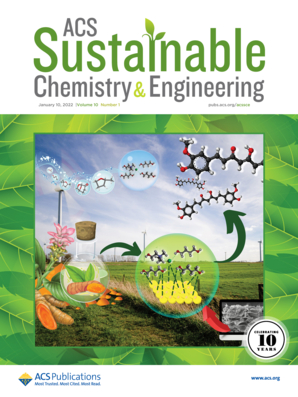Advancing Sustainable Ammonia Production via Solventless, Robust, and Thermally Conductive Absorbents
IF 7.1
1区 化学
Q1 CHEMISTRY, MULTIDISCIPLINARY
引用次数: 0
Abstract
Sorption-based low-pressure green ammonia synthesis using supported metal halide salts enables efficient interconversion between hydrogen and ammonia, allowing the high hydrogen density and well-established transportation network of ammonia to be used for green energy storage. Magnesium chloride supported on silica gel (MgCl2/SiO2) sorbent has been the subject of much investigation owing to its high capacity, selectivity, and reversibility at temperatures close to reactor conditions; however, MgCl2/SiO2 suffers from low thermal conductivity, which complicates absorber design at larger scales and prolongs absorption–desorption cycle times. We present a scalable, solventless method for supporting MgCl2 on thermally conductive aluminum fibers (MgCl2/Al)─a thermally conductive ammonia sorbent with a high working capacity of ∼220 mgNH3/gabsorbent. Although the solventless synthesis causes variance in initial-cycle pressure drop and capacity, we show that this stabilizes after cycling. The high thermal conductivity of MgCl2/Al allows for rapid absorption–desorption cycles, enabling easier scale-up. MgCl2/Al also maintains its cyclic capacity up to at least 50 cycles.

求助全文
约1分钟内获得全文
求助全文
来源期刊

ACS Sustainable Chemistry & Engineering
CHEMISTRY, MULTIDISCIPLINARY-ENGINEERING, CHEMICAL
CiteScore
13.80
自引率
4.80%
发文量
1470
审稿时长
1.7 months
期刊介绍:
ACS Sustainable Chemistry & Engineering is a prestigious weekly peer-reviewed scientific journal published by the American Chemical Society. Dedicated to advancing the principles of green chemistry and green engineering, it covers a wide array of research topics including green chemistry, green engineering, biomass, alternative energy, and life cycle assessment.
The journal welcomes submissions in various formats, including Letters, Articles, Features, and Perspectives (Reviews), that address the challenges of sustainability in the chemical enterprise and contribute to the advancement of sustainable practices. Join us in shaping the future of sustainable chemistry and engineering.
 求助内容:
求助内容: 应助结果提醒方式:
应助结果提醒方式:


